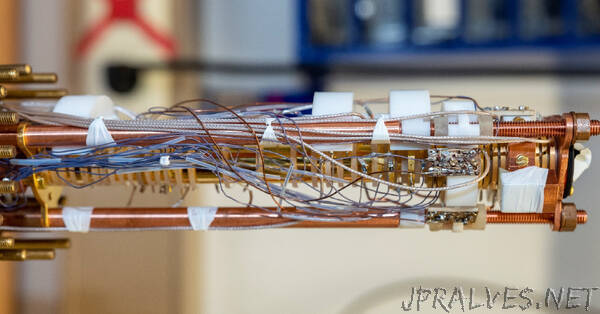
“In a significant technological advance for antimatter research, the BASE (Baryon Antibaryon Symmetry Experiment) collaboration has used laser-cooled ions to cool a proton more quickly and to lower temperatures than is possible using existing methods. The new technique, which introduces a separate Penning trap, promises to reduce the time needed to cool protons and antiprotons to sub-Kelvin temperatures from hours to seconds, potentially increasing the sample sizes available for precision matter-antimatter comparisons by orders of magnitude. As reported today in Nature, the collaboration’s test setup at the University of Mainz also reached temperatures approximately 10 times lower than the limit of the established resistive-cooling technique.
“The factor 10 reduction in temperature which has been achieved in our paper is just a first step,” says BASE deputy spokesperson Christian Smorra of the University of Mainz and RIKEN. “With optimised procedures we should be able to reach particle temperatures of order 20 mK to 50 mK, ideally in cooling times of order 10 seconds. Previous methods allowed us to reach 100 mK in 10 hours.”
The new setup consists of two Penning traps separated by 9 cm. One trap contains a single proton. The other contains a cloud of beryllium ions that are laser-cooled using conventional techniques. The proton is cooled as its kinetic energy is transferred through a superconducting resonant electric circuit into the cooler beryllium trap.
The proton and the beryllium ions can be thought of as mechanical oscillators within the magnetic and electric fields of the Penning traps, explains lead author Matthew Bohman of the Max Planck Institute for Nuclear Physics in Heidelberg and RIKEN. “The resonant electric circuit acts like a spring, coupling the oscillations — the oscillation of the proton is damped by its coupling to the conventionally cooled cloud of beryllium ions.”
The collaboration’s unique two-trap sympathetic-cooling technique was first proposed in 1990 by Daniel Heinzen and David Wineland. Wineland went on to share the 2012 Nobel prize in physics for related work in manipulating individual particles while preserving quantum information. The use of a resonant electric circuit to couple the two Penning traps is an innovation by the BASE collaboration which speeds up the rate of energy exchange relative to Heinzen and Wineland’s proposal from minutes to seconds. The technique is useful for protons, but game-changing for antiprotons.
Antiproton prospects
A two-trap setup is attractive for antimatter because a single Penning trap cannot easily accommodate particles with opposite charges, and laser-cooled ions are nearly always positively charged, with electrons stripped away. BASE previously cooled antiprotons by coupling them to a superconducting resonator at around 4 K, and painstakingly selecting the lowest energy antiprotons in the ensemble over many hours.
“With two-trap sympathetic cooling by laser-cooled beryllium ions, the limiting temperature rapidly approaches that of the ions, in the milli-Kelvin range,” explains Bohman. “Our technique shows that you can apply the laser-physics toolkit to exotic particles like antiprotons: a good antiproton trap looks pretty different from a good laser-cooled ion trap, but if you’re able to connect them by a wire or a coil you can get the best of both worlds.”
The BASE collaboration has already measured the magnetic moment of the antiproton with a record fractional precision of 1.5 parts per billion at CERN’s antimatter factory. When deployed there, two-trap sympathetic cooling has the potential to improve the precision of the measurement by at least a factor of 20. Any statistically significant difference relative to the magnetic moment of the proton would violate CPT symmetry and signal a dramatic break with the Standard Model.
“Our vision is to continuously improve the precision of our matter-antimatter comparisons to develop a better understanding of the cosmological matter-antimatter asymmetry,” says BASE spokesperson Stefan Ulmer of RIKEN. “The newly developed technique will become a key method in these experiments, which aim at measurements of fundamental antimatter constants at the sub-parts-per-trillion level. Further developments in progress at the BASE-logic experiment in Hanover will even allow the implementation of quantum-logic metrology methods to read-out the antiproton’s spin state.”
Further reading
M. Bohman et al. (BASE Collaboration) 2021 Nature DOI:10.1038/s41586-021-03784-w”
